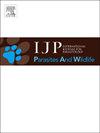Sarcocystis spp. and Toxoplasma gondii in muscles from wild boars (Sus scrofa) consumed in Switzerland
IF 2
3区 医学
Q3 ECOLOGY
International Journal for Parasitology-Parasites and Wildlife
Pub Date : 2025-07-09
DOI:10.1016/j.ijppaw.2025.101114
引用次数: 0
Abstract
Sarcocystis spp. and Toxoplasma gondii are heteroxenous protozoan parasites, which form cysts in muscle tissue of intermediate hosts (IH) and oocysts in the intestinal mucosa of definitive hosts (DH). Wild boars (Sus scrofa) are IH for Sarcocystis miescheriana (with wild and domestic canids as DH), S. suihominis (with humans and non-human primates as DH) and T. gondii (with felids as DH). The aim of this study was to identify and characterize Sarcocystis spp. and T. gondii in the muscle tissue of wild boars hunted and/or consumed in Switzerland. DNA was extracted from muscle samples of 286 wild boars and tested by PCRs targeting the 18S rRNA gene of Sarcocystis spp., the mitochondrial cytochrome c oxidase (cox1) gene of S. suihominis and by a qPCR targeting a 529 bp genomic repeat of T. gondii. Besides, 225 samples were processed by homogenization and direct microscopic examination and 42 samples by histopathology. Sarcocysts were detected microscopically in 89.3 % (201/225) and 35.7 % (15/42) of the samples, respectively. The 18S rRNA PCR detected parasite DNA in 91.3 % (261/286) of the samples, and all 62 sequences obtained were 100 % identical, and also with GenBank sequences reported as S. miescheriana, suggesting a high environmental contamination with canid faeces. The S. suihominis-cox1 PCR was positive in 1.75 % of the samples (5/286), and the six cox1 sequences (772 bp primers trimmed) obtained were 97.3–99.6 % similar among them and 97.7–100 % identical with a sequence reported as S. suihominis. Despite the identity differences, all these sequences were grouped together in a phylogenetic tree, in a sister clade of S. miescheriana sequences. All samples tested negative for T. gondii by qPCR. This study revealed for the first time the presence of S. suihominis in wild boars hunted in Switzerland.

瑞士食用野猪(Sus scrofa)肌肉中的肌囊虫和刚地弓形虫
Sarcocystis spp.和弓形虫(Toxoplasma gondii)是异种原生动物寄生虫,它们在中间宿主(IH)的肌肉组织中形成囊肿,在最终宿主(DH)的肠粘膜中形成卵囊。野猪(Sus scrofa)是米氏肉囊菌(以野生和家养犬科动物为DH)、猪链球菌(以人类和非人类灵长类动物为DH)和弓形虫(以猫科动物为DH)的DH。本研究的目的是鉴定和表征在瑞士狩猎和/或消费的野猪肌肉组织中的肌囊虫和弓形虫。从286只野猪的肌肉样本中提取DNA,分别以肉囊虫18S rRNA基因、猪链球菌线粒体细胞色素c氧化酶(cox1)基因和弓形虫529 bp基因组重复序列为目标进行pcr检测。225例经均质及直接显微镜检查,42例经组织病理学检查。显微镜下检出结节囊肿的比例分别为89.3%(201/225)和35.7%(15/42)。18S rRNA PCR检测到91.3%(261/286)的寄生虫DNA,获得的62条序列完全相同,且与GenBank报道的S. miescheriana序列一致,提示该虫与犬科动物粪便污染严重。1.75%的样本(5/286)的cox1 PCR阳性,得到的6条cox1序列(772 bp的引物)相似度为97.3 - 99.6%,与已报道的一条序列相同度为97.7 - 100%。尽管存在身份差异,但所有这些序列都被归类在一个系统发育树中,属于S. miescheriana序列的姐妹分支。所有样本经qPCR检测均为弓形虫阴性。这项研究首次揭示了在瑞士猎杀的野猪中存在猪链球菌。
本文章由计算机程序翻译,如有差异,请以英文原文为准。
求助全文
约1分钟内获得全文
求助全文
来源期刊

International Journal for Parasitology-Parasites and Wildlife
Medicine-Infectious Diseases
CiteScore
3.80
自引率
5.60%
发文量
113
审稿时长
45 days
期刊介绍:
The International Journal for Parasitology: Parasites and Wildlife (IJP-PAW) publishes the results of original research on parasites of all wildlife, invertebrate and vertebrate. This includes free-ranging, wild populations, as well as captive wildlife, semi-domesticated species (e.g. reindeer) and farmed populations of recently domesticated or wild-captured species (e.g. cultured fishes). Articles on all aspects of wildlife parasitology are welcomed including taxonomy, biodiversity and distribution, ecology and epidemiology, population biology and host-parasite relationships. The impact of parasites on the health and conservation of wildlife is seen as an important area covered by the journal especially the potential role of environmental factors, for example climate. Also important to the journal is ''one health'' and the nature of interactions between wildlife, people and domestic animals, including disease emergence and zoonoses.
 求助内容:
求助内容: 应助结果提醒方式:
应助结果提醒方式:


